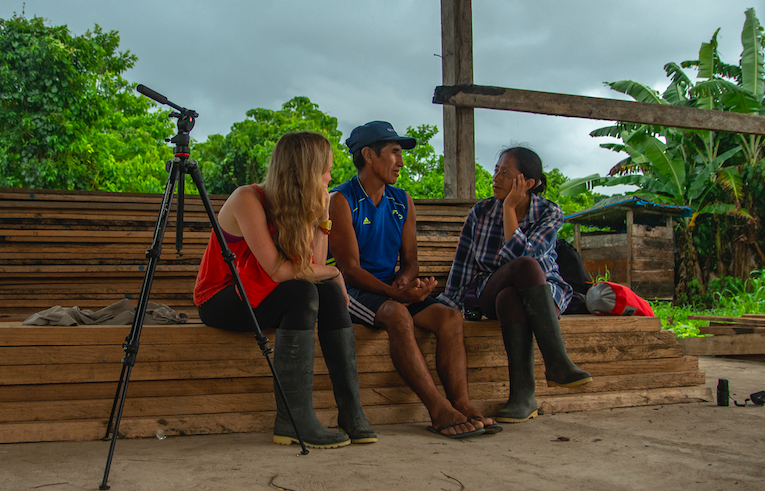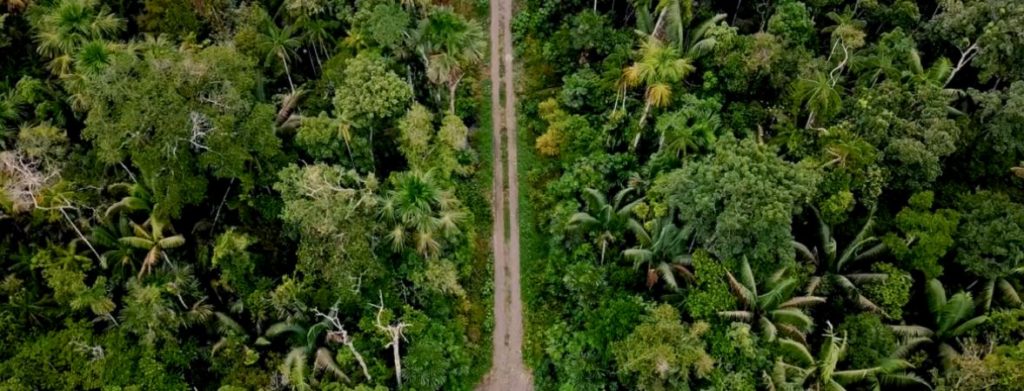Mongabay Latam
August 20, 2020
- A new documentary film about a road project in the Manu Biosphere Reserve in Peru’s southeastern Amazon chronicles an Indigenous community’s debate about its future.
- With the road will likely come new opportunities and problems: the area is already beset by illegal logging and narco-trafficking.
- Some in the community fear the problems will worsen and their culture will erode further, others say it’s the only way for the community to survive.
- The Peruvian government has prioritized road building in this area, and just announced that this road will be connected to the Interoceanic Highway, which will perhaps magnify the problems inside Manu.
Last week a new film was released that documents the building of a road into the Manu Biosphere Reserve in the Peruvian Amazon. It’s a story of conflict, community development, and deforestation deep in a protected rainforest. Produced by a team of women that spent weeks filming in Indigenous communities that both welcome and fear the road, “Voices on the Road” also features what the filmmakers call an impact campaign.
To learn more about the issue and their filmmaking strategy, Mongabay interviewed co-director and co-producer Bethan John via email.
Mongabay: Can you describe the region where the film is set, its people, and natural heritage?
Bethan John: Voices on the Road is set in a fascinating corner of Peru’s southeastern Amazon, a place called Manu Biosphere Reserve, which is rich in natural and cultural diversity. To get there, you travel across the dizzying heights of the Andes mountains, plunging down through elfin forest and cloud forest, to arrive in the streaming heat of the jungle. It’s this incredible altitudinal range that makes Manu so diverse and its remote location means it’s been relatively protected. Manu is home to endangered and endemic wildlife, as well as a number of different Indigenous communities, including some that live in voluntary isolation.

Peru has declared road building in this Amazon region a priority, a move that is also welcomed by the Indigenous Yine community at the heart of your film. What’s at stake for the people and their forest?
The Yine people from Diamante Native Community have been tirelessly campaigning for the road over many years, but they’re also extremely worried about what it will bring. There’s no doubt that it’ll increase illegal logging within their territory and land grabbing by ‘colonists’ from the Andes, who have moved to Manu to exploit the reserve’s natural resources.
Community members already feel threatened by the presence of narco-traffickers on their doorstep and the violence of police crackdowns, which they claim leads to the persecution of innocent people. Then there’s the erosion of their cultural identity and the fact that their language is already on the brink of being lost. There’s nothing being done to protect the forest or the community from these impacts. Yet the road is being offered as the only solution to the challenges they face.
You spent 40 days filming in the community: of all the things you learned and heard, what most surprised you?
As a team of environmentalists who have all worked in Manu for many years, we’ve come to really know the forest and its wild creatures. So the desire to see Manu properly protected is a deeply emotional feeling. We went into the expedition with preconceptions about loggers for the widespread destruction they’re causing, knowing that 90% of logging in the region is illegal.
After interviewing over 50 people from Indigenous communities, many of whom are illegal loggers, the change in our own attitude took us by surprise. We began to understand the level of systematic discrimination and disempowerment faced by communities that traps them in a cycle of destruction and poverty. There’s very little way of escaping the black market economy.
Here’s the film:
Just as you were releasing the film, the regional government announced a second phase to be completed in July 2021 that will connect the existing road to the Interoceanic Highway. What concerns do people have about that?
If this second phase of the road goes ahead then it will connect Manu to the heart of illegal gold mining in Peru, which is a hotbed of modern day slavery with the trafficking of boys into unpaid labor and girls into prostitution. It’s likely that the gold mining frontier will move into untouched areas of the rainforest and cause devastating levels of destruction.
Conservation organizations, state institutions and communities need to urgently come together to develop a strategy to address this threat, as currently there’s no plan to protect the area’s natural and cultural heritage. We’re hoping to use the film and Impact Campaign to facilitate discussion on the issue and further our understanding of what action is needed.
What techniques helped you capture this story the best?
We were interviewing community members about an extremely controversial and polarizing issue that has caused a lot of distress over many years. The last thing we wanted to do was to come along with an intimidating amount of equipment. We were also preparing for much of our filming to be run-and-gun, so we used the small and unobtrusive camera, the Canon XF400, for the majority of filming, including interviews, as well as GoPros and iPhones.
We believe this stripped back approach was partly why community members felt they could open up to us, meaning we were able to capture very personal stories. We also knew it would be important to see the road in situ and to show how it cuts through Manu’s dense forest, and so we used a Mavic drone for aerial shots.

You wrote for Mongabay last year about narco-trafficking in the region, and how corrupt police were also involved inside Manu. How is the new road’s eventual connection to the Interoceanic Highway likely to affect this situation?
Much of the cocaine in the region is destined for Brazil, the world’s second largest market, with access having been made much easier through the construction of the Interoceanic Highway. If the road connection goes ahead – and it seems extremely likely that it will – then it’ll have a dramatic impact on illicit coca production and cocaine trafficking in the region. Some of the people we interviewed in Diamante are already really fearful and the situation will get worse. Police corruption means they have no one they can trust to protect them.
Beside our Latin America bureau Mongabay-Latam, what sources of information do you recommend viewers consult to learn more?
If you’re looking for research papers on this specific road, then I’d recommend The Enchantments of Roads near Protected Areas in the Peruvian Amazon by Eduardo Salazar Moreira and The threat of road expansion in the Peruvian Amazon by Geoffrey Gallice. For more general updates on environmental issues impacting the region, then check out Monitoring of the Andean Amazon Project and SPDA Actualidad Ambiental. Of course, there’s also our website and social media network – Facebook, Instagram and Twitter – where we’ll be sharing regular updates.

Read more Mongabay coverage from Peru, of Indigenous peoples, deforestation, infrastructure, and the Amazon.
Banner image: The extension of the road through Manu has been a controversial issue for many years and will likely increase illegal activities in the region. Photo courtesy of Eilidh Munro.

